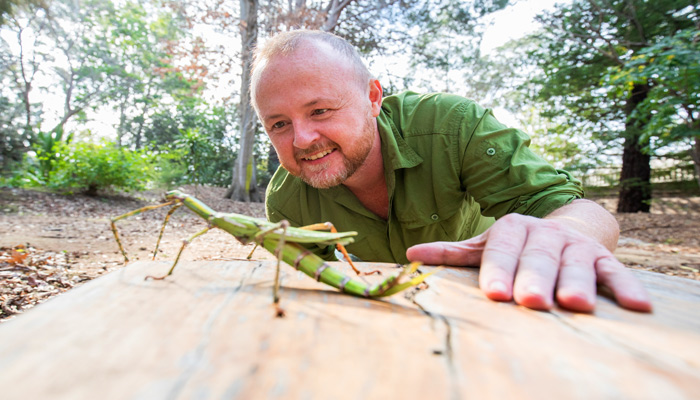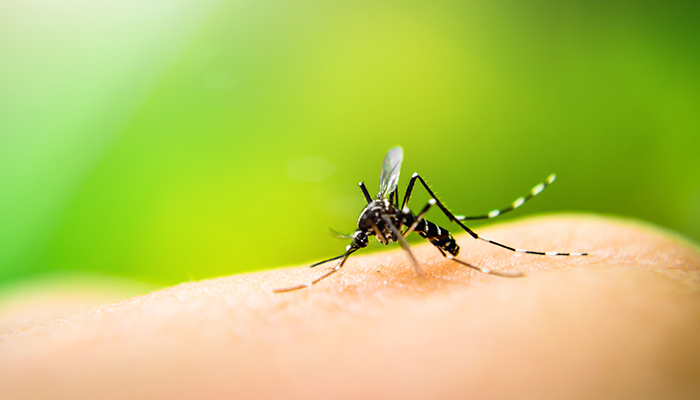A global scientific review of insect decline has warned that insects will “go down the path of extinction” in a few decades, with “catastrophic” repercussions for the planet’s ecosystems.
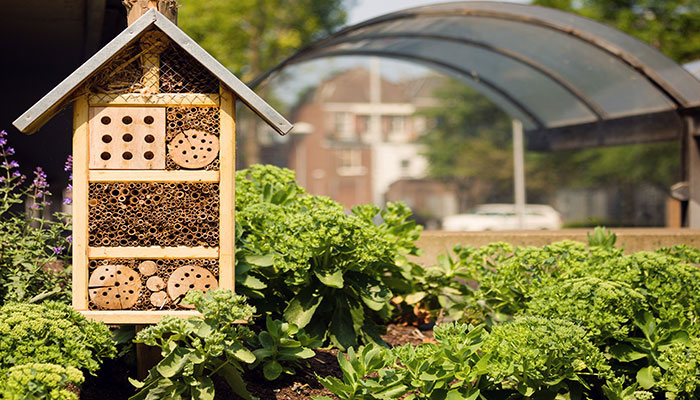
No vacancy: Insect hotels can be an art-inspired project for children and are designed to attract the kinds of insects you would like to see in your garden, says Dr Matthew Bulbert.
Intensive use of pesticides is identified as the No. 1 culprit, and the authors say humanity must change the ways it produces food to arrest the decline and save the planet as we know it.
Dr Matthew Bulbert, a lecturer and researcher in animal behaviour in Macquarie University’s Department of Biological Sciences, points out that ecosystems rely on insects – as the pollinators of plants and crops; the recyclers of waste into nutrients; and as a food source themselves – for fresh water, food and, ultimately, oxygen. We effectively cannot survive without them.
While Bulbert says investment in more long-term monitoring programs is urgently needed to get more quality data, particularly in Australia where insect biodiversity is so rich it is estimated 80 per cent of species are yet to be identified, there is no doubt that insects are in trouble.
“As scientists we know the decline is happening,” Bulbert says. “In Australia, we’re potentially losing animals that we don’t even know are there, and there is relatively little investment in that area of research.
“The good thing is that with insects, more so than if we were trying to save snow leopards or rhinos, every individual has it in their power to do something to try and mitigate further loss.”
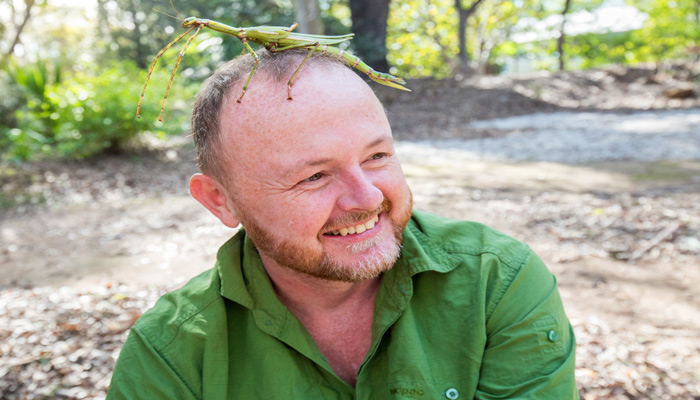
Insect whisperer: Dr Matthew Bulbert says the impact of insects on our wellbeing far surpasses any other conservation issue society invests money in.
Here are 10 things you can do now to help avert a global catastrophe
1. Build insect hotels
“I think they’re awesome,” Bulbert says. “You create art-inspired habitats for insects, often made out of lots of different shapes and types of wood – so you might have cylinders of wood that have different size diameter holes that would cater for different animals.
“The concept is not that far removed from a bird nest box. The cool thing is you can put a lot more structural diversity in there, and you can build it in a way that looks great in the garden, and tailor it, through the dimensions of holes and the types of materials, to the kinds of insects you would like to see in your garden.
“It’s a great exercise to include the kids.”
The literature on the best hotel designs is dominated by European references but the principles for an Australian environment are the same, Bulbert says.
As scientists we know the decline is happening. In Australia we are potentially losing animals that we don't even know are there.
2. Say no to pesticides
Find chemical-free ways of controlling insects you don’t want in your house and garden.
Many pest species have become resistant to the pesticides we use, which is problematic in itself, says Bulbert, but the spread of pesticides from crop areas takes out the suite of species diversity around that crop, even including the animals that naturally occur to control pests.
“This effect is occurring beyond just commercial enterprise; if you think of the build-up of household sprays across the populace, that’s a lot of chemicals out there that can have effects beyond just the animal you’re trying to target.“
People can consider these alternatives to grabbing a can of spray:
- Direct animals outside – for flying insects open a window and make other parts of the house dark to direct the insect towards the light; and for crawling ones capture and release.
- Ensure food scraps are secured in a way that doesn’t attract insects you don’t want – especially cockroaches. Of the 550 species of cockroaches in Australia, only six are considered pests. of which two are native. “The cockroaches that are commonly invasive to households are introduced,” says Bulbert. “They give Australia’s wonderful cockroaches a bad name, but native species are incredibly important in the breaking down of plant waste and thereby recycling the nutrients plants need.”
- In your garden, be proactive rather than reactive. Use natural fertilisers and netting, and consider the ancient art of companion planting. “This is about understanding what species you can put with the plants that you want to protect that can act as a natural deterrent,” Bulbert says. Local councils may offer workshops in this area, for example.
- Actively encourage natural predators, such as spiders both inside and out, and in the garden, insects such as ladybirds, praying mantids, lacewings and assassin bugs.
- The last resort, if you truly feel threatened by the insect invading your home and feel the need to kill it, stomp on it rather than spraying.
More detailed treatment of this topic can be found here.
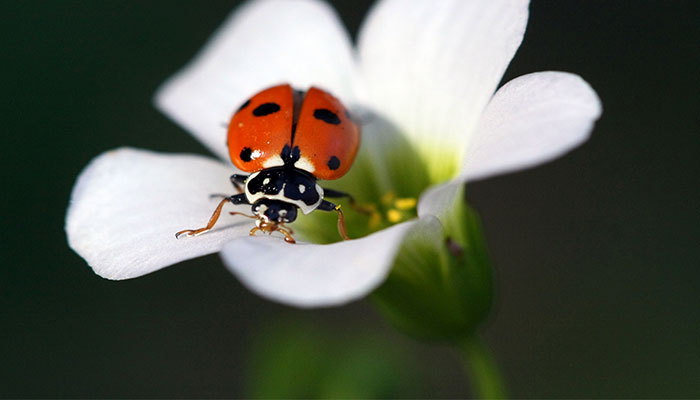
Fly away home: Ladybirds are great natural predators to have in your garden, says Bulbert.
3. Plant natives
Plant a diversity of native species, including ones that flower year-round. “If you plant natives, you will harbour or attract a higher diversity of insects,” Bulbert says.
“We have this thing about having brightly coloured flowers, but often those flowers are not native and while you will still get pollinators, it has been found that the diversity of insects that interact with non-natives is a lot lower - even if the plants are closely related to the native.
“In saying that, having plants that flower all year round is beneficial irrespective of whether they are native or not, especially in urban landscapes.”
Bulbert recommends checking out A planting guide for European honeybees and Australian native pollinators by the Australian Government.
4. Appreciate the little powerhouses
Just be fascinated by them, Bulbert says; take some time to observe and understand what they’re doing and why they do it, and relate that to your own wellbeing.
“People have trouble connecting with insects because they are small, we don’t see very much of them, they can be freaky looking and have attributes that bear no similarity to us, unlike, say, gorillas or giraffes, but the contribution they make to our wellbeing far surpasses anything else that we are investing money in in terms of conservation,” Bulbert says.
“Look at pandas – I love them, they have lots of cultural significance, and lots of roll-on attributes in terms of attracting people to zoos that may then have money for conservation for a range of things, but in reality the contribution a panda makes to society’s wellbeing is minimal in comparison to the worms in your garden.”
Helping to nurture appreciation are amateur societies such as the Society for Insect Studies. And if you want to be more in touch with research, see the Australian Entomological Society.
5. Make clean freshwater available
“Water features – bring them back!” says Bulbert. These can include ponds and fountains, anything in which the water keeps moving to avoid stagnation and mosquito breeding.
“If you want to find a depressing piece of literature it’s the decline of freshwater species overall, so making unpolluted freshwater available can promote animals like water beetles and water bugs.”

Citizen scientists: Involvement from the community helps contribute to the knowledge base of what is happening to our insects.
6. Use LED light globes
… and turn the lights off when you don’t need them, or use sensor lights. Research into light pollution caused by urbanisation shows major disruption to the goings-on of insects,
“A study in Sweden, for instance has shown artificial lights disrupt nocturnal pollination leading to a 62 per cent reduction in nocturnal visits to plants in artificially lit areas when compared to dark areas, leading to a significant decline in seed set.” Bulbert says
Insects are attracted to the wavelengths emitted by incandescent light globes, which redirects them away from the activities they are supposed to be doing. The beam of light can also impair the effectiveness of illumination methods flowers may use to attract pollinators.
Recent research has shown warm LEDs are best. If you don’t like their slight yellow-y/orange-y colour, then go for white LEDs, which are still better than traditional incandescents, Bulbert says.
7. Create shade oases
Maintaining vegetation is crucial for thermal buffering, particularly as episodes of extreme heat become more common, Bulbert says. “If you remove trees and other vegetation, you automatically start to get an increase in temperature at the ground level,” he says.
“There are temperature thresholds at which insects gets nuked, so you need the shade and cooling effects of vegetation and trees to avoid that.”
A lack of vegetation also hardens soil, making it less accessible to insects and other critters whose job it is to recycle material in the soil.
8. Invest in a worm farm
These recycling factories have many roll-on benefits aside from helping invertebrates: they are recycling waste that would otherwise go to landfill, and making natural fertiliser for your plants, thereby reducing the need for chemicals, Bulbert says.
“It’s important to invest in a nice secure environment so you can control what enters and what doesn’t – you’ve got a lovely food source for animals so it may attract things you don’t want, like rats, for instance.”
You can check in with your local council about any workshops they might run, Bulbert says; various businesses also offer classes.
9. Become a ‘citizen scientist’
“A major barrier for invertebrate research, but what also makes invertebrates so amazing, is their diversity – and to move forward we simply need more people involved,” Bulbert says.
Citizen science programs can help generate the many data points required to understand what is happening to insects.
Options in Australia are limited, Bulbert says, but include wild pollinator count, in which volunteers observe animals that come to their favourite gardens, and social networks such as QuestaGame, and iNaturalist, which contribute to campaigns that feed into the Atlas of living Australia.
You can also join a virtual expedition to digitise valuable information in our museums through DigiVol.
10. Advocate for a greater focus on biodiversity
In contrast to the US, Europe and the UK, Australia lacks a system of long-term biodiversity monitoring, including the dedicated infrastructure for citizen scientists to take part, Bulbert says.
“What we’ve seen in Australia instead is a reduction in investment in quality biodiversity monitoring - natural history museums have lost a lot of money; and there are very few dedicated entomology courses.
“We are fortunate in Australia in that we have had a concerted effort to set aside land and this has to be maintained without question, but for a long time we have been in the mentality of ‘if we leave it be, nature will be fine’.
“Unfortunately, as we are seeing, many of the threats to wildlife are not easily seen, such as pesticides of which the impacts are effectively invisible without ongoing monitoring.”
People could advocate for a greater focus on biodiversity by writing to their local MP or council, Bulbert suggests.
Dr Mathew Bulbert is a Senior Lecturer in the Macquarie University Department of Biological Sciences.

